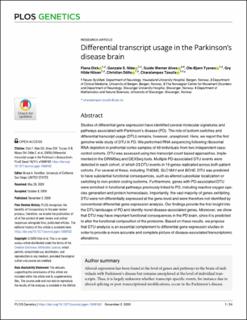| dc.contributor.author | Dick, Fiona | |
| dc.contributor.author | Sanchez Nido, Gonzalo | |
| dc.contributor.author | Alves, Guido Werner | |
| dc.contributor.author | Tysnes, Ole-Bjørn | |
| dc.contributor.author | Nilsen, Gry Hilde | |
| dc.contributor.author | Dölle, Christian | |
| dc.contributor.author | Tzoulis, Charalampos | |
| dc.date.accessioned | 2023-01-13T08:15:23Z | |
| dc.date.available | 2023-01-13T08:15:23Z | |
| dc.date.created | 2020-11-30T11:58:37Z | |
| dc.date.issued | 2020 | |
| dc.identifier.citation | Dick, F., Nido, G. S., Alves, G. W., Tysnes, O. B., Nilsen, G. H., Dölle, C., & Tzoulis, C. (2020). Differential transcript usage in the Parkinson’s disease brain. PLoS genetics, 16(11), e1009182. | en_US |
| dc.identifier.issn | 1553-7390 | |
| dc.identifier.uri | https://hdl.handle.net/11250/3043227 | |
| dc.description.abstract | Studies of differential gene expression have identified several molecular signatures and pathways associated with Parkinson’s disease (PD). The role of isoform switches and differential transcript usage (DTU) remains, however, unexplored. Here, we report the first genome-wide study of DTU in PD. We performed RNA sequencing following ribosomal RNA depletion in prefrontal cortex samples of 49 individuals from two independent case-control cohorts. DTU was assessed using two transcript-count based approaches, implemented in the DRIMSeq and DEXSeq tools. Multiple PD-associated DTU events were detected in each cohort, of which 23 DTU events in 19 genes replicated across both patient cohorts. For several of these, including THEM5, SLC16A1 and BCHE, DTU was predicted to have substantial functional consequences, such as altered subcellular localization or switching to non-protein coding isoforms. Furthermore, genes with PD-associated DTU were enriched in functional pathways previously linked to PD, including reactive oxygen species generation and protein homeostasis. Importantly, the vast majority of genes exhibiting DTU were not differentially expressed at the gene-level and were therefore not identified by conventional differential gene expression analysis. Our findings provide the first insight into the DTU landscape of PD and identify novel disease-associated genes. Moreover, we show that DTU may have important functional consequences in the PD brain, since it is predicted to alter the functional composition of the proteome. Based on these results, we propose that DTU analysis is an essential complement to differential gene expression studies in order to provide a more accurate and complete picture of disease-associated transcriptomic alterations. | en_US |
| dc.language.iso | eng | en_US |
| dc.publisher | Public Library of Science (PLoS) | en_US |
| dc.rights | Navngivelse 4.0 Internasjonal | * |
| dc.rights.uri | http://creativecommons.org/licenses/by/4.0/deed.no | * |
| dc.title | Differential transcript usage in the Parkinson’s disease brain | en_US |
| dc.type | Peer reviewed | en_US |
| dc.type | Journal article | en_US |
| dc.description.version | publishedVersion | en_US |
| dc.rights.holder | the authors | en_US |
| dc.subject.nsi | VDP::Medisinske Fag: 700 | en_US |
| dc.source.pagenumber | 1-24 | en_US |
| dc.source.volume | 16 | en_US |
| dc.source.journal | PLoS Genetics | en_US |
| dc.source.issue | 11 | en_US |
| dc.identifier.doi | 10.1371/journal.pgen.1009182 | |
| dc.identifier.cristin | 1854049 | |
| dc.source.articlenumber | e1009182 | en_US |
| cristin.ispublished | true | |
| cristin.fulltext | original | |
| cristin.qualitycode | 2 | |

